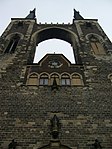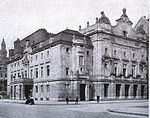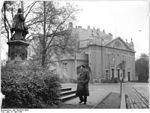Bernhard Sehring

Ernst Bernhard Sehring (1 June 1855 in
Life
Sehring came from a petty-bourgeois village background and was the son of a
Shortly after he was accepted into the Architekten- und Ingenieurverein zu Berlin-Brandenburg, he received the Schinkel Prize, his first architectural award, in 1882 for his designs for the Museum Island.[2] In 1883, he received the Großer Akademischer Staatspreis.[3]
As a state scholarship holder in Rome (1883 and 1884), he took part in an international theatre building competition for the first time and opened the architectural firm Peters and Sehring with Ernst Peters in
Sehring became known for his designs, especially competition designs, theatre and other new buildings. At the
From 1907 to 1921, he built his family's summer residence, the
Buildings and drafts
- 1889–1890: Künstlerhaus St. Lukas in Berlin, Fasanenstraße 13 (unter Denkmalschutz)
- 1890–1895: Wohnhaus Kantstraße 153 in Berlin-Charlottenburg (erster Wohnsitz von Rudolf Diesel)
- 1891(?): Königin-Luise-Gedächtnishalle in Neustrelitz
- 1892: Mehrfamilienwohnhaus-Paar in Berlin, Carmerstraße 10/11
- 1895–1896: Theater des Westens in Berlin-Charlottenburg, Kantstraße
- 1895–1896: Westtürme der Köthen (Anhalt)
- 1895–1896: Theater „Alt-Berlin“ auf der Berliner Gewerbeausstellung1896 in Berlin-Treptow (abgebrochen 1897)
- 1899–1900: Fassade des Warenhauses der H. & C. Tietz AG in Berlin, Leipziger Straße 46–49 (im Zweiten Weltkrieg zerstört)
- 1901: Hexentanzplatz bei Thale(Harz)
- 1902–1904: Stadttheater in Bielefeld, Niederwall 27 (innen 1937 verändert, 2004–2006 denkmalgerecht saniert)
- 1903–1904: Villa Löwenpalais in Berlin-Grunewald, Koenigsallee 30/32 (unter Denkmalschutz)
- 1904–1905: Schauspielhaus in Düsseldorf, Kasernenstraße (im Zweiten Weltkrieg zerstört)
- 1904–1905: Stadttheater in Halberstadt (im Zweiten Weltkrieg zerstört)
- 1905: Bismarck-Brunnen in Breslau, Schlossplatz / Königsplatz
- 1906–1910: Stadthalle / Musikhalle in Görlitz, Am Stadtpark 1
- 1907–1908: Stadttheater (heutiges Staatstheater) in Cottbus, Schillerplatz
- 1907–1920: Roseburg castle in Ballenstedt, Sehrings Sommersitz
- before 1914: Expansion of Reisen castle
- before 1914: Reconstruction of the Berlin Wintergarten theatre in Berlin, Friedrichstraße
- 1927–1928: Kino Delphi-Palastin Berlin-Charlottenburg, Kantstraße / Fasanenstraße (Heavily damaged in the Second World War, façade and garden design reconstructed)
-
Theater des Westens in Berlin
-
Löwenpalais in Berlin
-
West towers of St. Jakob in Köthen
-
Walpurgishalle (historical coloured postcard)
-
Stadttheater Bielefeld
-
Schauspielhaus Düsseldorf
-
Stadthalle Görlitz (as of 1959)
-
Staatstheater Cottbus (historical coloured postcard)
-
Ballenstedt, Roseburg
References
- ^ Der Schwarze Ring. Mitgliederverzeichnis. Darmstadt 1930, p. 39.
- ^ Verzeichnis der preisgekrönten Wettbewerbsentwürfe um den Schinkelpreis. In Wochenschrift des Architekten-Vereins zu Berlin, 6. Jahrgang 1911, Nr. 10 (11 March 1911), p. 54, retrieved 15 June 2021.
- ^ Zentralblatt der Bauverwaltung, 3. Jahrgang 1883, Nr. 47 (24 November 1883) (Online), p. 434.
- ^ Hanssen, Frederik (17 August 2014). "Der Bühnenturm des Theaters des Westens". Der Tagesspiegel. Retrieved 15 June 2021.
- ISBN 978-3-902666-55-0. Retrieved 15 June 2021.
Further reading
- Ralph Berndt: Bernhard Sehring und die Roseburg. Ein Ensemble des Späthistorismus im Harz. In Die Gartenkunst (1/1999), pp. 22–29.
External links
- Biografie und Werkverzeichnis Sehrings auf den Internetseiten der Roseburg, retrieved 15 June 2021
- Bestand zu Bernhard Sehring in Architekturmuseum der Technischen Universität Berlin, retrieved 15 June 2021









